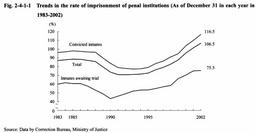| Previous Next Index Image Index Year Selection | |
|
|
Prisons and juvenile prisons are institutions whose principal role is to house those offenders sentenced to imprisonment with or without labor or to penal detention for the execution of their sentences and provide necessary treatment for them. Detention houses are institutions that mainly house inmates awaiting trial (defendants and suspects in detention; hereinafter the same). In general, prisons, juvenile prisons, and detention houses are collectively called penal institutions. Penal institutions have workhouses in which offenders who are unable to pay fines or minor fines are detained, and except for some penal institutions also have houses of Kanchi confinement in which persons subject to confinement as the punishment for contempt of court (Kanchi confinement) under the provision of Article 2 of the Law for Maintenance of Order in Court-Room etc. are detained.
As of April 1, 2003, there were 74 penal institutions (59 prisons, 8 juvenile prisons and 7 detention houses) and 115 branch institutions (5 branch prisons and 110 branch detention houses throughout Japan). As of December 31, 2002, the imprisonment capacity of penal institutions was 65,264 inmates (including 49,309 convicted inmates), while the actual number of imprisoned inmates was 69,502 (including 57,451 convicted inmates). Fig. 2-4-1-1 shows the trends in the rate of imprisonment (the rate of actual inmates to the capacity) since 1983. As of December 31, 2002, the rate of imprisonment was 106.5% for all inmates (up by 5.3 points from the previous year) and 116.5% for convicted inmates (up by 6.8 points), which indicates that slightly less than 90% of penal institutions housed inmates beyond their capacity (Source: Data by Correction Bureau, Ministry of Justice). Staff who work at penal institutions are prison officers (officials in the Ministry of Justice with custodial authority under the Prison Law) as well as technical and educational officers in the Ministry of Justice. Fig. 2-4-1-1 Trends in the rate of imprisonment of penal institutions (As of December 31 in each year in 1983-2002) |
